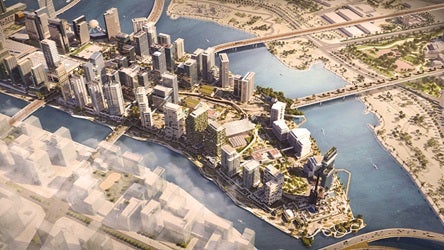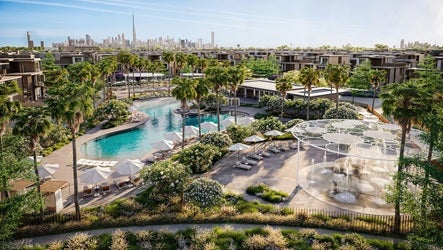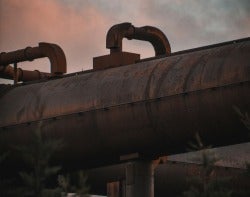Legacy building at Diriyah
1 August 2024
It is impossible to talk about Saudi Arabia’s history without referencing Diriyah. Founded in 1446 in the Wadi Hanifa valley on the western outskirts of Riyadh, the historic town was the first capital of the Al-Saud dynasty and the launchpad for the kingdom’s unification campaign at the turn of the 20th century. In recognition, its central Turaif district was inscribed as a Unesco World Heritage site in 2010.
Today, the mud-brick settlement, built in the distinctive Najdi architectural style, has lent its name to one of the world’s most ambitious transformative developments. Sensitively conserving and building on its historical importance, it has created a unique cultural, educational, residential and tourism hub in the capital.
With an official budget of some $63bn, Diriyah is one of Saudi Arabia’s five official gigaprojects. It has held this label since early 2023, when responsibility for its development was handed to Diriyah Company, a project company formed as a Public Investment Fund (PIF) subsidiary a year earlier.
Covering an area of 14 square kilometres, Diriyah is targeting a population of 100,000 by its stated completion date of 2030. With more than 40 hotels, nine museums, 400 luxury boutiques, 100-plus restaurants and multiple educational institutions, it hopes to draw in more than 50 million annual visits.
Progress since ground was first broken four years ago has been rapid. As of May 2024, more than SR53bn ($14.1bn)-worth of construction contracts had been awarded. Today, visitors to the area can see hundreds of mobile cranes, plant and piling equipment rising over the boundary wall.
“We are in a good place,” says Mohammed Saad, Diriyah Company’s chief development officer. “We’ve finished our essential underground infrastructure and civil works, the super basement and all the tunnels that connect the basements together.”
But the real work has only just begun. Saad says a further SR30bn-35bn is scheduled to be awarded by the end of 2024, rising to SR40bn-45bn in 2025. By the end of this year, the public can expect to see substantial above-ground construction, particularly on the western side of the gigaproject, providing more tangible evidence of its advancement, which until now has been primarily below ground.
This is not to say that any vertical assets will be particularly tall. Because of the district's traditional low-rise nature, any building must be no higher than the historic structures. It should also emulate the Najdi style. For the same reason, most of the essential infrastructure, utilities and roads are hidden below ground.
Major project scopes
A significant step was made in early July when Diriyah Company awarded an estimated $2bn contract to a joint venture of El-Seif Engineering & Contracting and China State to build the North Cultural District. The deal, the largest let on the gigaproject to date, covers multiple assets, including hotels, the King Salman Foundation Library, King Salman University and the House of Saud Museum.
The work was originally planned as multiple construction packages until Diriyah Company took the commercial decision last year to bundle them into one contract. The decision to adopt super packages was driven by a dynamic market in which contractors have been almost overwhelmed with the volume of tenders from various gigaprojects and where cost inflation is taking hold.
“You will not get the attention of the big contractors if you offer small contracts,” Saad explains. By consolidating projects, contractors can focus their resources more effectively and efficiently and provide more competitive pricing.
“We have a hotel, we have an office building, we have a museum, and when we tendered them as one super package, there was a very solid response and interest from the big players because they could focus their resources and pricing and more efficiently engage their supply chains and subcontractors.”
The approach appears to be working. In late July, another estimated $2bn super package was awarded to a joint venture of local contractor Albawani and Qatar’s Urbacon to construct assets in the Wadi Safar district of the gigaproject. Featuring a mix of residential, residential farm plots, hotels, branded hotel villas, a golf course, an equestrian and polo club, and other leisure and entertainment facilities, including Aman, Chedi, Faena and Six Senses-branded hotels, Wadi Safar is positioned as the most upscale and exclusive development in Riyadh and indeed the kingdom as a whole.
The consolidated contract packages strategy reflects the supercharged nature of the Saudi projects market. With various clients, including the gigaprojects, all competing for a limited amount of contracting, material and labour resources, more innovative procurement strategies need to be adopted.
This is particularly critical for Diriyah and its enormous material requirements. For example, it has previously said that it will ultimately need some 350,000 doors, 1.5 million square metres of tiles, 1.2 million tonnes of rebar and 140,000 HVAC units.
Supply-side obstacles
Despite the progress, the project faces challenges related to contracting, engineering and material supply. The high demand for key materials, coupled with global supply chain disruptions, poses a significant conundrum. However, the delivery team has proactively secured and signed framework agreements with manufacturers to ensure a steady flow of required materials.
Transparent demand signalling is a core component of this. “We’ve analysed our material needs up to 2030 and prepared comprehensive requests for proposals for all key items,” says Saad. “We went out to the manufacturers and the supply chain in general to let them see the pipeline is tangible and secure. We are listening to vendors in order to speed things up and to lock down prices.”
Saad lists specific materials not naturally available in Saudi Arabia, such as finishing stones, as items that may be in short supply, in addition to some specialised MEP equipment that is only manufactured abroad. Overall, he is optimistic about the market’s ability to adapt. “The market will adjust itself,” he states. “Of course, there are challenges, but there are also opportunities for manufacturers to up their game.”
Likewise, contractors are being brought into discussions at earlier stages of contract planning. Diriyah is adopting strategies such as early contractor involvement in the design process to help better understand and manage construction risk. “We’re engaging with contractors and delivery partners as early as the concept design stages to get their feedback on the project’s constructability,” says Saad. “Later, these contractors can be invited to bid for the contract, which makes it easier for them and so they can be aware of any issues.”
Financial constraints
Another increasingly evident challenge is financing. As the gigaprojects programme steps up a gear, there have been growing strains on funding the huge costs associated with it, expenditure which in some cases is considerably higher than when first estimated during the initial master planning stages due to cost inflation and disruptions in the supply chain.
As with the other gigaprojects, Diriyah’s initial work has been fully funded by its PIF parent, but later phases will likely require other financing mechanisms. While some of this will come from the $100m in revenues it expects to make over the next year, the client company has been actively tapping into the capital markets, following in the footsteps of other gigaprojects such as Neom and Red Sea Global, which have concluded sizeable borrowing deals in the past two years.
This includes all options up to and including an initial public offering (IPO). The market consensus is that eventually all the PIF project company subsidiaries will go public when the time is right, and Diriyah is unlikely to be an exception.
For the same reason, the client is also exploring public-private partnerships (PPPs) to enable the private sector to take on some of the financial burden. For instance, City Cool Cooling Company recently won a $186m 25-year build-own-operate (BOO) concession to develop a 72,000-refrigeration-tonne district cooling plant. Future opportunities may include expansion of cooling capacity, other utilities and car parking operations.
“PPPs are a key component of our strategy,” says Saad. They provide a platform for private investors to participate in Diriyah's growth while leveraging the expertise and resources of the public sector. We realise we cannot build 10 million square metres alone. We need the private sector to participate and partner with us and give them an opportunity to be part of this journey.”
Another funding source will be off-plan property sales once its real estate offering comes to market. Based on the development plans, this is expected to be significant. With a mix of some 30,000 villas, apartments and townhouses, the ambition is to attract both local and expatriate residents, if or when the kingdom opens its property market to non-nationals.
Investment pathway
Eventually, third parties will also need to invest in the various real estate elements of the gigaproject. Diriyah Company, as a master developer, is actively seeking to attract other developers, family offices and financial institutions to develop land parcels for mixed-use, residential, hospitality, commercial, education and healthcare assets.
“We are already opening up to investors and meeting developers who are interested in partnering with us or buying land,” notes Saad. “It’s a good problem to have – there’s more interest than we can handle right now, which speaks volumes about the project's attractiveness.”
This is just as well. One criticism of the gigaprojects programme has been the shortfall in both local and international investment to date. A lack of understanding of what the gigaprojects are and will be, demand uncertainty, timeframe ambiguities and general market hesitancy have been identified as the stumbling blocks.
Diriyah is determined to change this situation. It is focusing on increasing public and investor awareness of the potential opportunity through initiatives such as its two-day Bashayer event last November, which showcased the masterplan and construction progress to selected key stakeholders. There has also been a push for greater transparency and publishing more specific details about the overall development to make it stand out from the crowded market.
The giant gigaproject is not being developed in isolation. Experience from successful developments worldwide highlights that connectivity and coordination with other government stakeholders are key. Diriyah is planned to be connected to an extension of Riyadh Metro’s Line 2 and a planned Line 7 linking it with King Khalid International airport and another gigaproject, Qiddiya. In total, four metro stations are planned for the development.
At the same time, talks are under way for Diriyah to be one of the main stations on the planned Q-Express high-speed rail link between the airport and Qiddiya, which will complement the metro network. For those arriving by car, there will be the opportunity to use the three-level, 1 million square-metre underground ‘super basement’ car park, which, with a capacity for 10,500 vehicles, will be the fifth-largest parking facility in the world, and by far the biggest in the region.
As Diriyah’s construction accelerates, it is already starting to define its identity more clearly. Building on the kingdom’s historical roots, it is set to create a new legacy for future generations.
Exclusive from Meed
-
 Regional rail industry emerges
Regional rail industry emerges8 December 2025
-
 Aldar and Mubadala plan $16bn financial district expansion
Aldar and Mubadala plan $16bn financial district expansion8 December 2025
-
 Visa agrees to support digital payments in Syria
Visa agrees to support digital payments in Syria5 December 2025
-
 Meraas announces next phase of Nad Al-Sheba Gardens
Meraas announces next phase of Nad Al-Sheba Gardens5 December 2025
-
 Frontrunner emerges for Riyadh-Qassim IWTP
Frontrunner emerges for Riyadh-Qassim IWTP5 December 2025
All of this is only 1% of what MEED.com has to offer
Subscribe now and unlock all the 153,671 articles on MEED.com
- All the latest news, data, and market intelligence across MENA at your fingerprints
- First-hand updates and inside information on projects, clients and competitors that matter to you
- 20 years' archive of information, data, and news for you to access at your convenience
- Strategize to succeed and minimise risks with timely analysis of current and future market trends

Related Articles
-
 Regional rail industry emerges
Regional rail industry emerges8 December 2025
 Commentary
Commentary
Colin Foreman
EditorRead the December issue of MEED Business Review
The GCC is experiencing a fundamental shift in its approach to rail infrastructure, as it moves from standalone projects to a self-sustaining regional industry. The transition is evident as local, national and regional projects advance across the region.
The first wave of metro systems, in Dubai, Doha, and most recently, Riyadh, have reported stronger-than-expected ridership and demonstrated the viability of mass transit in the Gulf.
Extensions to those networks are planned or under way, including Dubai’s Blue and Gold lines and Riyadh’s Line 2, alongside planned metros elsewhere such as Muscat and Bahrain.
Projects are also planned and already being delivered at the national level. The UAE’s Etihad Rail and Saudi Arabian Railways are leading most of these efforts. The region’s first cross-border project is also progressing with the Hafeet Rail scheme linking the UAE and Oman.
Other cross-border schemes are planned, including high speed links connecting Riyadh with Doha and Kuwait City, and rail links for Bahrain across causeways to Saudi Arabia and Qatar. The ultimate ambition is a GCC Rail network – a project that was reinvigorated by the Al-Ula accords in 2021.
Sustained, simultaneous activity across the GCC is fostering the development of an indigenous regional rail industry. Rather than being executed as isolated endeavours, projects are creating ongoing demand for expertise, personnel and resources within the region.
Project delivery capability will be complemented by the establishment of crucial ancillary services, including fabrication and servicing facilities.
These operations will shift the GCC from a lucrative market for international contractors to a regional hub for the rail industry, capable of servicing and sustaining its growing network.
 READ THE DECEMBER 2025 MEED BUSINESS REVIEW – click here to view PDF
READ THE DECEMBER 2025 MEED BUSINESS REVIEW – click here to view PDFProspects widen as Middle East rail projects are delivered; India’s L&T storms up MEED’s EPC contractor ranking; Manama balances growth with fiscal challenges
Distributed to senior decision-makers in the region and around the world, the December 2025 edition of MEED Business Review includes:
> AGENDA 1: Regional rail construction surges ahead> INDUSTRY REPORT 1: Larsen & Toubro climbs EPC contractor ranking> INDUSTRY REPORT 2: Chinese firms expand oil and gas presence> CONSTRUCTION: Aramco Stadium races towards completion> RENEWABLES: UAE moves ahead with $6bn solar and storage project> INTERVIEW: Engie pivots towards renewables projects> BAHRAIN MARKET FOCUS: Manama pursues reform amid strainTo see previous issues of MEED Business Review, please click herehttps://image.digitalinsightresearch.in/uploads/NewsArticle/15213797/main.gif -
 Aldar and Mubadala plan $16bn financial district expansion
Aldar and Mubadala plan $16bn financial district expansion8 December 2025
Register for MEED’s 14-day trial access
Abu Dhabi's sovereign wealth fund, Mubadala Investment Company, and local developer Aldar have established a joint venture to deliver an expansion of the financial district on Al-Maryah Island with a gross development value of AED60bn-plus ($16bn-plus).
The development will be built on the undeveloped land bank on the north side of Al-Maryah Island, covering about 500,000 square metres (sq m), and will support the next phase of growth for Abu Dhabi Global Market (ADGM).
The masterplan encompasses 1.5 million sq m of new office, residential, retail and hospitality floor space.
In an official statement, the firms said that the core objective of the project is to support the continued expansion of ADGM, Abu Dhabi’s international financial centre. ADGM now has more than 11,000 active licences registered in the free zone and is among the fastest-growing financial hubs globally.
"Nearly 40,000 people are already based within the district, and demand for space remains strong," the statement added.
The Al-Maryah Island expansion will add over 450,000 sq m of Grade A office space, doubling the island’s current office inventory.
The expansion will add over 3,000 residences on the waterfront.
The next phase will also add a further 40,000 sq m of retail and dining spaces.
A central feature of the expansion is the Al-Maryah Waterfront enhancement project. This will include a bay fountain capable of water displays up to 75 metres high, forming the focal point of a reconfigured waterfront with additional dining, leisure and event spaces designed to complement existing assets on the island.
Three new bridges are proposed to link the north side of Al-Maryah Island with Reem Island and the Abu Dhabi mainland, reducing travel time to Saadiyat Island to under 10 minutes.
The enabling works on these projects are due to begin in 2026.
The new joint venture is owned 60% by Aldar and 40% by Mubadala.
"The two organisations are close to completing the legal work on a retail joint venture that will own and operate several of Abu Dhabi’s leading retail destinations, including The Galleria Al-Maryah Island, Yas Mall and the planned Saadiyat Grove Mall," the statement added.
 READ THE DECEMBER 2025 MEED BUSINESS REVIEW – click here to view PDF
READ THE DECEMBER 2025 MEED BUSINESS REVIEW – click here to view PDFProspects widen as Middle East rail projects are delivered; India’s L&T storms up MEED’s EPC contractor ranking; Manama balances growth with fiscal challenges
Distributed to senior decision-makers in the region and around the world, the December 2025 edition of MEED Business Review includes:
> AGENDA 1: Regional rail construction surges ahead> INDUSTRY REPORT 1: Larsen & Toubro climbs EPC contractor ranking> INDUSTRY REPORT 2: Chinese firms expand oil and gas presence> CONSTRUCTION: Aramco Stadium races towards completion> RENEWABLES: UAE moves ahead with $6bn solar and storage project> INTERVIEW: Engie pivots towards renewables projects> BAHRAIN MARKET FOCUS: Manama pursues reform amid strainTo see previous issues of MEED Business Review, please click herehttps://image.digitalinsightresearch.in/uploads/NewsArticle/15213568/main.jpg -
 Visa agrees to support digital payments in Syria
Visa agrees to support digital payments in Syria5 December 2025
Visa and the Central Bank of Syria have agreed on a strategic roadmap that will allow the US-based card and digital payments company to begin operations in Syria and support the development of a modern digital payments system.
Under the agreement, Visa will work with licensed Syrian financial institutions under a phased plan to establish a secure foundation for digital payments.
The early stages will involve Visa supporting the central bank in issuing Europay, Mastercard and Visa (EMV)-compliant payment cards and enabling tokenised digital wallets – bringing the country in line with internationally interoperable standards.
Visa will also provide access to its platforms, including near-field communication (NFC) and QR-based payments, invest in local capacity building and support local entrepreneurs seeking to develop solutions leveraging Visa’s global platform.
“A reliable and transparent payment system is the bedrock of economic recovery and a catalyst that builds the confidence required for broader investment to flow into the country,” noted Visa’s senior VP for the Levant, Leila Serhan. “This partnership is about choosing a path where Syria can leapfrog decades of legacy infrastructure development and immediately adopt the secure, open platforms that power modern commerce.”
The move marks one of the most significant steps yet in Syria’s slow and uneven return to the formal global financial system and carries implications that reach beyond just payments technology.
It lays the groundwork for overturning more than a decade of financial isolation in which Syria has operated largely outside global banking and settlement networks.
Visa’s entry will not erase all existing barriers – as many restrictions remain in force and will continue to shape what is practically possible – but its support signals a reopening of channels that could smooth Syria’s reintegration into financial networks.
The involvement of the US-based payments provider is also a further tacit sign of the US government’s enthusiastic bear hug of the new post-Assad Syrian government under President Ahmed Al-Sharaa.
For investors assessing long-term opportunities, the presence of a globally recognised payments operator will provide reassurance that Syria’s financial system is returning to international norms, and the security and transparency that comes with it.
https://image.digitalinsightresearch.in/uploads/NewsArticle/15207198/main3225.gif -
 Meraas announces next phase of Nad Al-Sheba Gardens
Meraas announces next phase of Nad Al-Sheba Gardens5 December 2025
Dubai-based real estate developer Meraas Holding, which is part of Dubai Holding, has announced the eleventh and final phase of its Nad Al-Sheba Gardens residential community in Dubai.
It includes the development of 210 new villas and townhouses and a school, which will be located at the northwest corner of the development.
The latest announcement follows Meraas awarding a AED690m ($188m) contract for the construction of the fourth phase of the Nad Al-Sheba Gardens community in May, as MEED reported.
The contract was awarded to local firm Bhatia General Contracting.
The scope of the contract covers the construction of 92 townhouses, 96 villas and two pool houses.
The contract award came after Dubai-based investment company Shamal Holding awarded an estimated AED80m ($21m) contract to UK-based McLaren Construction last year for the Nad Al-Sheba Gardens mall.
The project covers the construction and interior fit-out of a two-storey mall, covering an area of approximately 12,600 square metres.
The UAE’s heightened real estate activity is in line with UK analytics firm GlobalData’s forecast that the construction industry in the country will register annual growth of 3.9% in 2025-27, supported by investments in infrastructure, renewable energy, oil and gas, housing, industrial and tourism projects.
The residential construction sector is expected to record an annual average growth rate of 2.7% in 2025-28, supported by private investments in the residential housing sector, along with government initiatives to meet rising housing demand.
https://image.digitalinsightresearch.in/uploads/NewsArticle/15206904/main.jpg -
 Frontrunner emerges for Riyadh-Qassim IWTP
Frontrunner emerges for Riyadh-Qassim IWTP5 December 2025

Saudi Arabia’s Vision Invest has emerged as frontrunner for the contract to develop the Riyadh-Qassim independent water transmission pipeline (IWTP) project, according to sources.
State water offtaker Saudi Water Partnership Company (SWPC) is preparing to award the contract for the IWTP "in the coming weeks", the sources told MEED.
The project, valued at about $2bn, will have a transmission capacity of 685,000 cubic metres a day. It will include a pipeline length of 859 kilometres (km) and a total storage capacity of 1.59 million cubic metres.
In September, MEED reported that bids had been submitted by two consortiums and one individual company.
The first consortium comprises Saudi firms Al-Jomaih Energy & Water, Al-Khorayef Water & Power Technologies, AlBawani Capital and Buhur for Investment Company.
The second consortium comprises Bahrain/Saudi Arabia-based Lamar Holding, the UAE's Etihad Water & Electricity (Ewec) and China’s Shaanxi Construction Installation Group.
The third bid was submitted by Saudi Arabia's Vision Invest.
It is understood that financial and technical bids have now been opened and Vision Invest is likely to be awarded the deal.
The Riyadh-based investment and development company made a "very aggressive" offer, one source told MEED.
In November, the firm announced it had sold a 10% stake in Saudi Arabia-based Miahona as part of a strategy to reallocate capital "towards new and diversified investments".
The company did not disclose which projects the capital might be reallocated towards.
As MEED recently reported, Vision Invest is also bidding for two major packages under Dubai's $22bn tunnels programme in a consortium with France's Suez Water Company.
The Riyadh-Qassim transmission project is the third IWTP contract to be tendered by SWPC since 2022.
The first two are the 150km Rayis-Rabigh IWTP, which is under construction, and the 603km Jubail-Buraydah IWTP, the contract for which was awarded to a team of Riyadh-based companies comprising Al-Jomaih Energy & Water, Nesma Group and Buhur for Investment Company.
Like the first two IWTPs, the Riyadh-Qassim IWTP project will be developed using a 35-year build-own-operate-transfer contracting model.
Commercial operations are expected to commence in the first quarter of 2030.
https://image.digitalinsightresearch.in/uploads/NewsArticle/15206609/main.jpg

